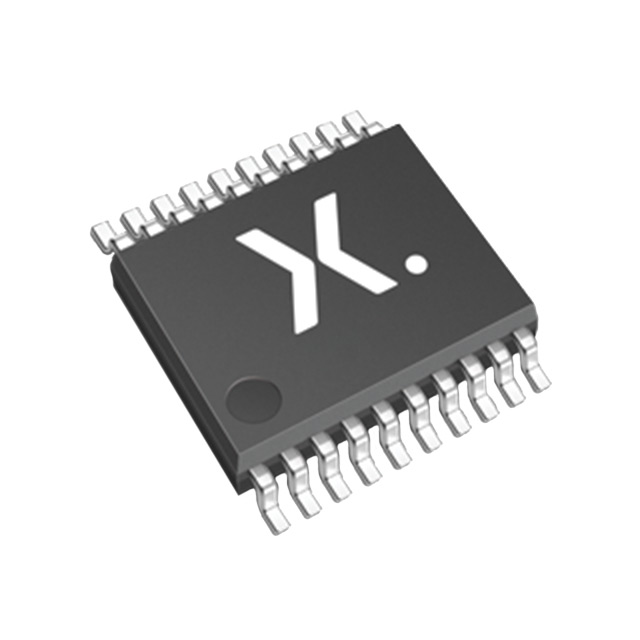Lihat spesifikasi untuk detail produk.

74LVC240APW,118
Basic Information Overview
- Category: Integrated Circuit (IC)
- Use: Logic Level Shifter
- Characteristics: Low Voltage CMOS Octal Buffer/Line Driver with 5V Tolerant Inputs and Outputs
- Package: TSSOP (Thin Shrink Small Outline Package)
- Essence: The 74LVC240APW,118 is a high-performance octal buffer/line driver designed for low voltage applications.
- Packaging/Quantity: Available in tape and reel packaging, with 2500 units per reel.
Specifications
- Supply Voltage Range: 1.2V to 3.6V
- High-Speed CMOS Technology
- Output Drive Capability: ±24mA at 3.3V
- Schmitt-trigger Action on All Inputs
- Overvoltage-Tolerant Inputs and Outputs
- Power-Off Protection Mode
- ESD Protection: HBM JESD22-A114E (Human Body Model), exceeds 2000V
- Operating Temperature Range: -40°C to +125°C
Detailed Pin Configuration
The 74LVC240APW,118 has a total of 20 pins, which are arranged as follows:
+----+--+----+
A1 -|1 +--+ 20|- VCC
A2 -|2 19|- B1
A3 -|3 18|- B2
A4 -|4 17|- B3
A5 -|5 16|- B4
A6 -|6 15|- B5
A7 -|7 14|- B6
A8 -|8 13|- B7
GND -|9 12|- B8
OE1 -|10 11|- OE2
+------------+
Functional Features
- The 74LVC240APW,118 is designed to shift logic levels between different voltage domains.
- It provides buffering and line driving capabilities for up to eight independent input/output lines.
- The device operates at low voltage levels, making it suitable for battery-powered applications.
- Schmitt-trigger inputs ensure robust signal reception even in the presence of noise.
- Overvoltage-tolerant inputs and outputs allow interfacing with higher voltage systems.
- Power-off protection mode prevents damage during power supply fluctuations.
- ESD protection ensures high reliability in handling electrostatic discharge events.
Advantages and Disadvantages
Advantages: - Wide supply voltage range allows compatibility with various systems. - High-speed CMOS technology enables fast data transmission. - Schmitt-trigger inputs enhance noise immunity. - Overvoltage tolerance provides flexibility in system integration. - Power-off protection enhances device durability. - ESD protection ensures reliable operation in harsh environments.
Disadvantages: - Limited output drive capability compared to some other ICs. - Not suitable for high-voltage applications.
Working Principles
The 74LVC240APW,118 operates by receiving input signals and shifting their logic levels to match the desired output voltage domain. It utilizes CMOS technology to achieve high-speed data transmission while consuming low power. The Schmitt-trigger inputs help in reducing noise-induced errors, ensuring reliable signal reception. The overvoltage-tolerant inputs and outputs enable seamless interfacing with systems operating at higher voltages. The power-off protection mode safeguards the device from potential damage during power supply fluctuations. Overall, the working principle revolves around providing efficient buffering and line driving capabilities for low voltage applications.
Detailed Application Field Plans
The 74LVC240APW,118 finds application in various fields, including but not limited to: - Battery-powered devices - Portable electronics - Communication systems - Industrial automation - Automotive electronics - Consumer electronics
Detailed and Complete Alternative Models
Some alternative models that offer similar functionality to the 74LVC240APW,118 are: - SN74LVC240A by Texas Instruments - MC74LVC240A by ON Semiconductor - CD74LVC240 by Texas Instruments - 74LCX240 by Fairchild Semiconductor - HCF240 by STMicroelectronics
These alternative models can be considered based on specific requirements and availability in different regions.
Word count: 337 words
Sebutkan 10 pertanyaan dan jawaban umum terkait penerapan 74LVC240APW,118 dalam solusi teknis
Sure! Here are 10 common questions and answers related to the application of 74LVC240APW,118 in technical solutions:
Q: What is the function of the 74LVC240APW,118? A: The 74LVC240APW,118 is an octal buffer/line driver with 3-state outputs. It is used for signal buffering and driving in digital circuits.
Q: What is the supply voltage range for the 74LVC240APW,118? A: The supply voltage range for the 74LVC240APW,118 is typically between 1.65V and 5.5V.
Q: How many inputs and outputs does the 74LVC240APW,118 have? A: The 74LVC240APW,118 has 8 inputs and 8 outputs.
Q: Can the 74LVC240APW,118 handle high-speed signals? A: Yes, the 74LVC240APW,118 is designed to handle high-speed signals with a maximum propagation delay of 6 ns.
Q: Does the 74LVC240APW,118 support bidirectional communication? A: No, the 74LVC240APW,118 is a unidirectional buffer and does not support bidirectional communication.
Q: What is the maximum output current that the 74LVC240APW,118 can drive? A: The 74LVC240APW,118 can drive up to 24 mA of output current per channel.
Q: Is the 74LVC240APW,118 compatible with both CMOS and TTL logic levels? A: Yes, the 74LVC240APW,118 is compatible with both CMOS and TTL logic levels.
Q: Can the 74LVC240APW,118 be used in a mixed-voltage system? A: Yes, the 74LVC240APW,118 has 5V tolerant inputs, making it suitable for use in mixed-voltage systems.
Q: Does the 74LVC240APW,118 have built-in ESD protection? A: Yes, the 74LVC240APW,118 has built-in ESD protection to prevent damage from electrostatic discharge.
Q: What package does the 74LVC240APW,118 come in? A: The 74LVC240APW,118 is available in a TSSOP-20 package.
Please note that these answers are general and may vary depending on the specific datasheet and manufacturer's specifications for the 74LVC240APW,118.

